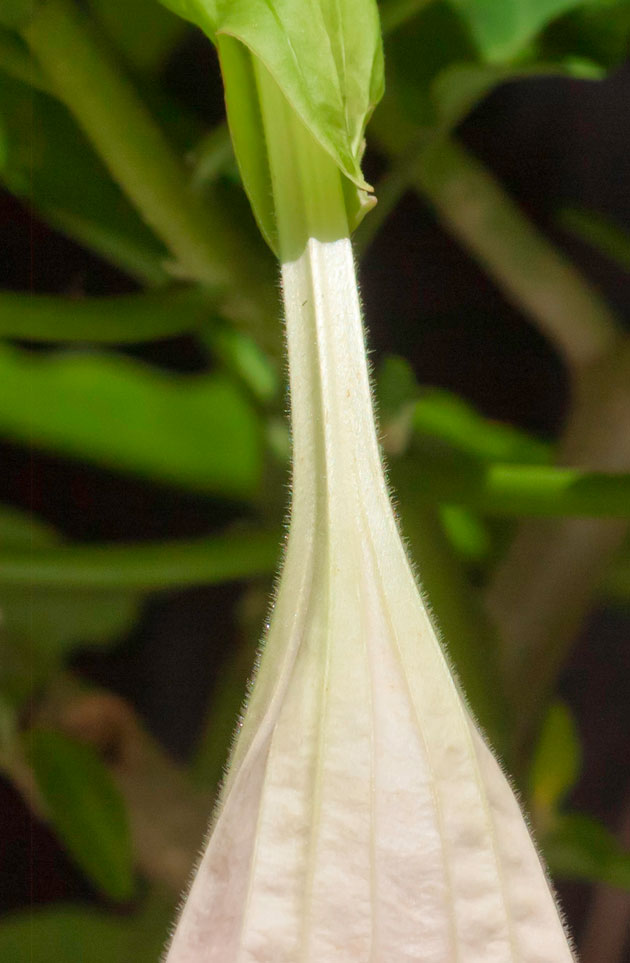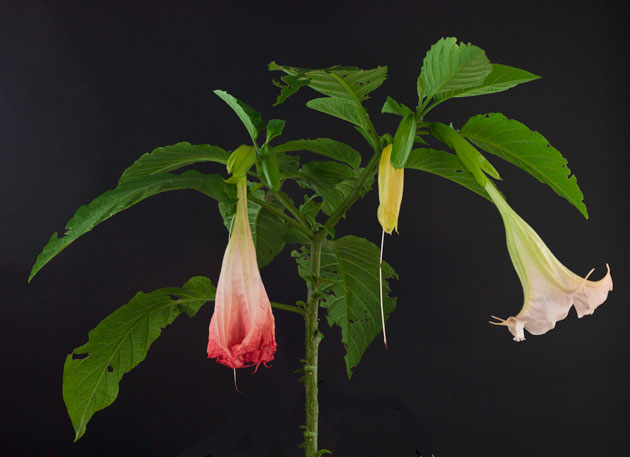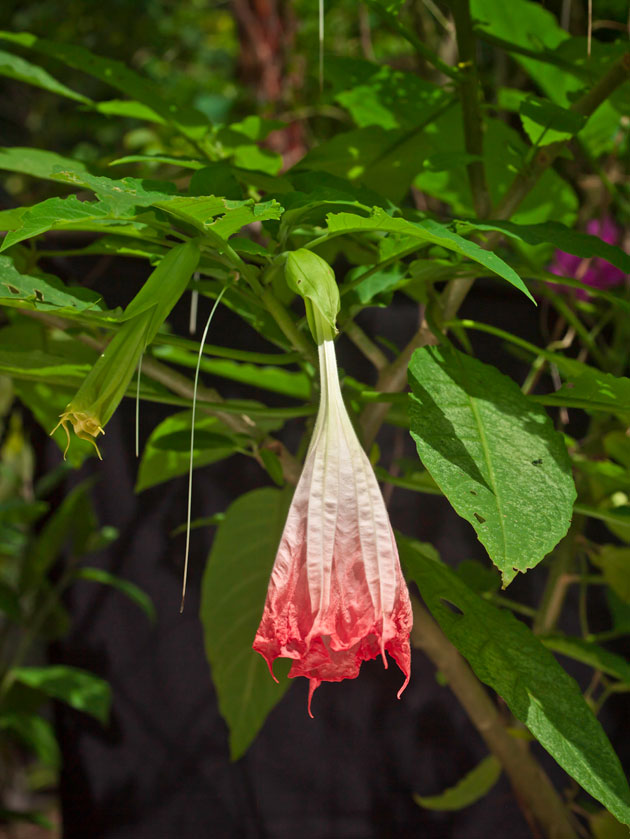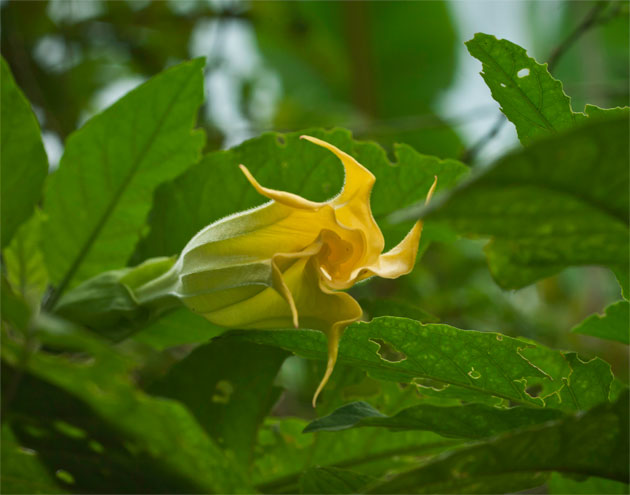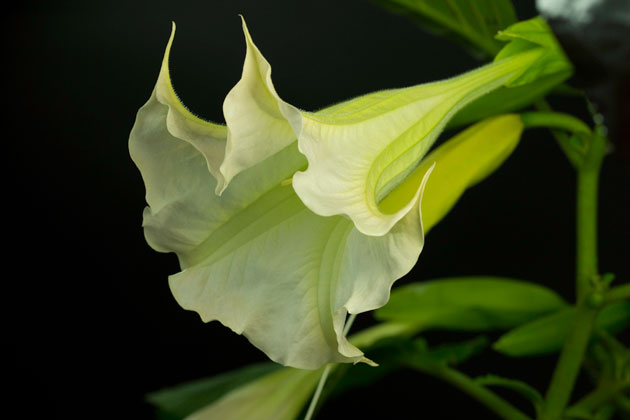Brugmansia arborea is a popular garden flower throughout the tropics
We found this plant in our garden. We also see yellow Brugmansia in nurseries. These are popular garden flowers throughout tropical America. They require no particular care and grow like a contented weed. Then occasionally they begin to flower and you have gorgeous flowers for many days (my shrub is not that large).
When I returned from lecturing in South Africa and installing my photo exhibit in St Louis at MOBOT on sacred Maya flowers, I found the plant flowering. There were about eight dead flowers already on the ground; three flowers in full bloom, and about nine buds.
This is the height of the autumn rainy season, at 1500 meters elevation, Guatemala City.
One part of the tree actually had fallen to the ground and was almost like a ground vine. Part in the middle had taken root. But it was still producing flowers at the end.
The rest of the shrub was upright.
We noticed no fragrance whatsoever with the flowers of Brugmansia arborea
Unless you stick your nose deep into the flower, during the day there was no odor. And at night I did not notice much either. In distinction, huele de noche and flor de nardo have a delectable fragrance. These other two flowers are noticeable to your nose many meters away.
But, when I went to the plant about 9 pm, and cut one of the flowers to bring it into the photo studio, I noticed it did indeed offer a remarkable fragrance, like sweet enticing flavored milk. Not the overpowering fragrance of huele de noche or flor de nardo. And not the amazing fragrance of the Brugmansia tree in the nursery in Antigua Guatemala (which has over 70 flowers at a time). But the pink flower did have a potentially alluring odor.
Since the plant is toxic, hallucinogenic and probably even more nasty features I did not want to inhale any more. But I can understand that if you were the High Priest, or Shaman or King, you might want to stick your face into the flower for several minutes.
Imagine if you had a dozen other flowers available with additional chemicals.
Fortunately I prefer to photograph the natural beauty of these flowers. I find life quite educational, learning about plants and animals, so I do not feel the need to destroy my brain and damage the remains of my body just to get a momentary high.
Flowers pop open in the early evening
Two of the blossoms opened before 7:30 pm. Whether they open only at night is hard to tell since our shrub is not that large.
We photographed theBrugmansia flower outside, and then in our studio
About 20 minutes after the half-opened bud was in our studio, it suddenly popped fully open. This amazed the photographer, Sofia Monzon.
The different stages of the Florifundia as it opened during the photo shoot in our studio. Images by Sofia Monzon using a Canon EOS Rebel T2i.
We use fluorescent lighting courtesy of F.J. Westcott, so there is no heat to melt the poor flowers. We put them in lots of water. So a combination of the water and the light probably caused the flower to open.
Later I brought in two buds, and neither of them opened even after being under light for three hours. I guess they were not yet open enough to be triggered by the fluorescent lighting.
These two angel trumpet buds did not open under the light. Burgmansia arborea, florifundia image taken in FLAAR Studio by Nicholas Hellmuth using a Phase One A/S P25+.
Buds of Brugmansia arborea are yellow; flower is initially white; when mature flower is pink
At first I thought the tree was producing several different colors of flowers. But later we figured out that
- The buds are yellow
- The flower opens and is white
- The flower is pink the next day and dies as a pink flower
Angel trumpet flowers in different stages. FLAAR Studio, photo by Nicholas Hellmuth using a Phase One A/S P25+.
Brugmansia arboreais native to South America so Mesoamerican usage needs to be confirmed
Brugmansia arborea is considered to be from South America, so whether it was grown in Mesoamerica before arrival of the Spaniards needs to be confirmed. I would estimate that a flower as pretty as this for a garden, and a plant with as many hallucinogenic chemicals would have been desired two thousand years ago. But before we all start talking about the Maya using this plant, we need proof that it is pre-Columbian in Mesoamerica.
Most identifications of flowers in Maya art are in error
If you see anyone calling a flower in Maya art a Datura, you have to ask whether they are familiar with the newest botanical awareness of the Solanaceae, nightshade, family. Datura have flowers pointing up; Brugmansia have flowers pointing down. Both kinds of plant deserve further study to see which was available to the pre-Columbian Maya of Guatemala and nearby areas.
Brugmansia have flowers pointing down. Photo by Nicholas Hellmuth using a Phase One A/S P25+.
We are not studying hallucinogens. But if you wish to learn which plants to avoid, the monographs by Christian Ratsch are the best. You can also look at the book by Michael Wink and Ben-Erik Van Wyk.
Our interest is to see which plants were used by the Maya; which not. And which flowers appear in Maya art. After several years of research we have noticed that most and often all identifications of flowers in Maya art are inaccurate. The exception are identifications by botanist Charles Zidar, Missouri Botanical Garden. Ratsch is pretty accurate also.
Brugmansia arborea is rarely correctly identified as such.. Photo by Nicholas Hellmuth using a Phase One A/S P25+.
Probably 60% to often 90% of the identifications of flowers in books by most writers on the Lacandon Maya of Lowland Chiapas are in error (they all focus too much on Plumeria). The sad fact is that many of the ethnographers who have lived and worked with the Lacandon have seemingly never gone out and actually studied each and every flower. Their names for most of the Lacandon flowers-of-deity-generation are incorrect. There are potentially three species involved; so far more than only Plumeria. We have high resolution photographs of all three flowers.
The Brugmansia arborea is not mentioned in most studies of the Lacandon and rarely featured in most research on the Maya use of flowers (the flowers which are important tend to be given other names, which we have indicated are mostly incorrect). I mention the error on the Lacandon plant names because there is a comparable mish mash of illogical naming between Datura and Brugmansia.
Most parts of this Brugmansia arborea plant are toxic
Florifundia is a toxic plant. Brugmansia arborea flower, image by Sofia Monzon using a Canon EOS Rebel T2i
Do not touch the plant without gloves; wash your hands afterwards, and resist any silly temptation to eat any part of the plant. This plant, and its relatives, are toxic.
You see more Brugmansia in Guatemala than Datura
Most of the trumpet-shaped flowers you see in gardens as you drive through villages throughout Guatemala have flowers that are hanging down. Most of these are Brugmansia. So I do not see Datura as often.
First posted September 11, 2012.
More text added September 12, 2012.



